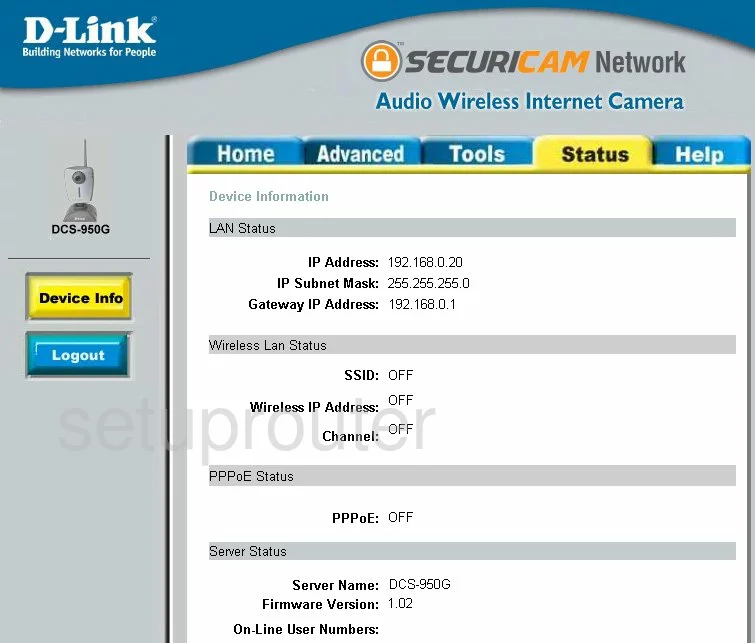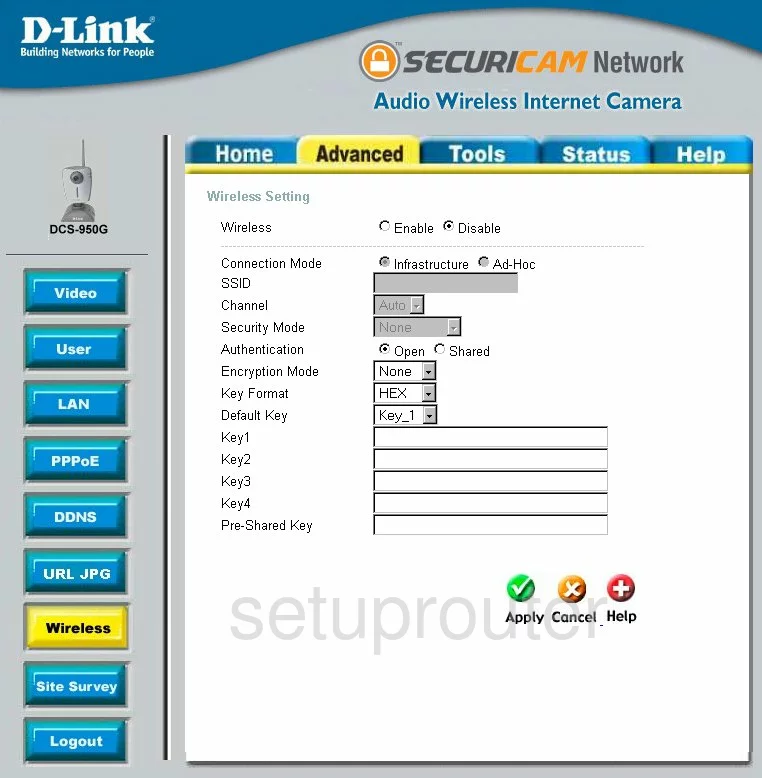The Dlink DCS-950G router is considered a wireless router because it offers WiFi connectivity. WiFi, or simply wireless, allows you to connect various devices to your router, such as wireless printers, smart televisions, and WiFi enabled smartphones.
Other Dlink DCS-950G Guides
This is the wifi guide for the Dlink DCS-950G. We also have the following guides for the same router:
- Dlink DCS-950G - How to change the IP Address on a Dlink DCS-950G router
- Dlink DCS-950G - Dlink DCS-950G Login Instructions
- Dlink DCS-950G - Dlink DCS-950G User Manual
- Dlink DCS-950G - How to change the DNS settings on a Dlink DCS-950G router
- Dlink DCS-950G - How to Reset the Dlink DCS-950G
- Dlink DCS-950G - Dlink DCS-950G Screenshots
- Dlink DCS-950G - Information About the Dlink DCS-950G Router
WiFi Terms
Before we get started there is a little bit of background info that you should be familiar with.
Wireless Name
Your wireless network needs to have a name to uniquely identify it from other wireless networks. If you are not sure what this means we have a guide explaining what a wireless name is that you can read for more information.
Wireless Password
An important part of securing your wireless network is choosing a strong password.
Wireless Channel
Picking a WiFi channel is not always a simple task. Be sure to read about WiFi channels before making the choice.
Encryption
You should almost definitely pick WPA2 for your networks encryption. If you are unsure, be sure to read our WEP vs WPA guide first.
Login To The Dlink DCS-950G
To get started configuring the Dlink DCS-950G WiFi settings you need to login to your router. If you are already logged in you can skip this step.
To login to the Dlink DCS-950G, follow our Dlink DCS-950G Login Guide.
Find the WiFi Settings on the Dlink DCS-950G
If you followed our login guide above then you should see this screen.

You should begin on the Home page of the Dlink DCS-950G internet camera. The first thing you do to setup the WiFi is click the Advanced tab at the top of the page. Then, look in the left sidebar and click the option of Wireless.
Change the WiFi Settings on the Dlink DCS-950G

On this new page, the things that need to be changed are:
- First of all, make sure your Wireless is Enabled.
- SSID - This is the name you give your network so that you can ascertain which is yours. We recommend using no personal information in this name for safety reasons. To learn more about SSID's read our Wireless Names Guide.
- Channel - Use this drop list to make sure you are using the correct channel. If you have any neighbors you should be using channels 1,6, or 11 to avoid interference. Overlapping channels cause a lot more interference than completely sharing a channel. To learn more about this topic, read our WiFi Channels Guide.
- Security Mode - The best choice available for this firmware version is WPA-PSK. We recommend updating your firmware to allow for WPA2-PSK. This is the best option for wireless networks right now. To learn more about security options, read our WEP vs. WPA Guide.
- Encryption Mode - If you have not upgraded your firmware, choose TKIP. If you have upgraded, choose AES. TKIP has some flaws that have made it easier to crack. AES is considered very secure.
- The Key Format should be set to ASCII.
- Pre-Shared Key - This is the password you are to use to gain access to your wireless network. We recommend at least 20 characters here. You should also avoid personal information, it is easier to guess than you might think. Avoid properly spelled or commonly misspelled words. To learn how to create a strong and memorable password, read our Choosing a Strong Password Guide.
That's it, when you are finished, click the green check mark titled Apply.
Possible Problems when Changing your WiFi Settings
After making these changes to your router you will almost definitely have to reconnect any previously connected devices. This is usually done at the device itself and not at your computer.
Other Dlink DCS-950G Info
Don't forget about our other Dlink DCS-950G info that you might be interested in.
This is the wifi guide for the Dlink DCS-950G. We also have the following guides for the same router:
- Dlink DCS-950G - How to change the IP Address on a Dlink DCS-950G router
- Dlink DCS-950G - Dlink DCS-950G Login Instructions
- Dlink DCS-950G - Dlink DCS-950G User Manual
- Dlink DCS-950G - How to change the DNS settings on a Dlink DCS-950G router
- Dlink DCS-950G - How to Reset the Dlink DCS-950G
- Dlink DCS-950G - Dlink DCS-950G Screenshots
- Dlink DCS-950G - Information About the Dlink DCS-950G Router